Article
Kami may look like a real person, but she is actually a computer graphics animation made of pixels, who only exists on-screen.
The young social media user - who has a bright smile and long, purple hair - was created as a way to counter the ‘perfect’ internet personas and the lack of high profile people who have disabilities.
She was created by Down Syndrome International (DSi), creative agency Forsman & Bodenfors (F&B), and global digital modelling agency The Diigitals.
They teamed up to make the virtual influencer since they said the 'digital world isn't an inclusive space.'
The three companies wanted to give people with disabilities someone to relate to, since they said almost all influencers looks 'curated, filtered, and pixel perfect.'


Kami may look like a real person, but she is actually a computer graphics animation made of pixels, who only exists on-screen
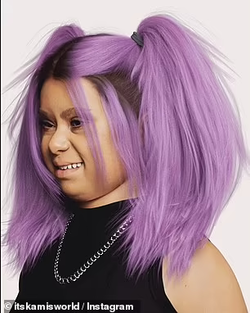

The young social media user - who has a bright smile and long, purple hair - was created as a way to counter the ‘perfect’ internet personas
Kami, short for the name Kamilah, means perfection in Arabic, and that is how they want the world to see her.
The group explained, 'Despite being a more connected society, the digital world is yet to fully embrace diversity.
'Avatars that allow us to choose an “ideal” face and body lead to the heavy underrepresentation and the reduced visibility of people with disabilities.
'By intentionally giving Down syndrome to someone who is universally known as "perfect" in the social sphere, Kami will be a powerful representation that Down syndrome is not a flaw, or a mistake, and that she does not need "fixing."'
For Kami to be a truly authentic representation of real women with Down syndrome, a panel of over 100 young women volunteers with Down syndrome across the DSi global network were consulted to collaborate on her creation as a virtual model - acting as the faces, physiques, gestures, voices, and personalities that Kami will embody.
'The digital world isn't an inclusive space. Everyone looks curated, filtered, pixel perfect - but change is coming,' an introduction video shared to her Instagram account reads.
'Meet Kami,' it continued. 'The world's first virtual influencer with Down syndrome. I'm not real but I'm made from hundreds of real women with one common mission - to make the digital world a place where everyone truly belongs.'

She was created by Down Syndrome International (DSi), creative agency Forsman & Bodenfors (F&B), and global digital modelling agency The Diigitals



A panel of over 100 young women volunteers with Down syndrome were consulted to collaborate on her creation

The three companies wanted to give people with disabilities someone to relate to, since they said almost all influencers looks 'curated, filtered, and pixel perfect'
One of the women volunteers with Down syndrome is Jaspreet Sekhon, from Singapore.
Jaspreet said: 'I don’t really see people with Down syndrome on social media. I wish there was more like us.
'If I saw more people with Down syndrome, it would make us confident in ourselves. Show people what we can do and then show it on social media.'
According to a study published by the Institute of Digital Fashion, as reported by Adweek, 60 per cent of people said there was a lack of inclusivity in digital spheres.
'In a world filled with pixel perfect virtual models, creating Kami is a way to completely reframe Down syndrome in the online space,' added Rachel Kennedy and Firrdaus Yusoff, creatives for Forsman & Bodenfors Singapore.
'We want to make it impossible to ignore Kami and everything she stands for. As we get to know her, Kami’s true potential will depend on how the world embraces her in her virtual form.'
Adweek reported that Kami was created through using 'both machine learning and human craft.'
'Portraits of the women were aligned before being added to a face averaging program to produce a single image,' the outlet explained.
'A 3D character creator program called Daz3D then generated the initial concept and face of Kami.
'With this prototype, the team crafted her human features - from her eyelashes to skin textures - in 3D form. The avatar can be imported into different platforms.'
'We really wanted Kami’s DNA to represent all the faces and aspects of these women with Down syndrome, which the program allowed us to do,' said Cameron James-Wilson, founder and CEO of The Diigitals.
'Creating characters like Kami signify a challenge to the many layers of digital interface that currently lack inclusivity.

It turns out, this isn't the first virtual influencer. Back in 2016, an LA-based company called Brud created a fake person named Miquela Sousa, also known as Lil Miquela (pictured)

The effortlessly cool 19-year-old robot has since racked up more than three million followers, and has modeled for brands such as Prada and Chanel
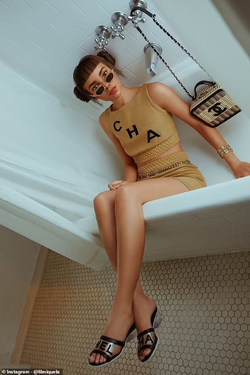
Miquela was created with a different approach than Kami. From her Brazilian background to the cute freckles on her nose, everything about her is manufactured to appear perfect
'We need to address some of the glaring problems in this space and build the online world we want for the future.'
You can follow Kami on Instagram at @itskamisworld, where she has already gained around 800 followers.
It turns out, this isn't the first virtual influencer. Back in 2016, an LA-based company called Brud created a fake person named Miquela Sousa, also known as Lil Miquela, and started sharing her pictures online.
The effortlessly cool 19-year-old robot has since racked up more than three million followers, and has modeled for brands such as Prada and Chanel, which pay good money to have their products adorn her close-to-perfect body.
However, Miquela was created with a different approach than Kami. From her exotic Spanish-Brazilian background to the cute freckles on her nose (designed to give her an imperfect beauty and make her more ‘relatable’), everything about her is manufactured.
It is said that the ‘virtual influencers’ have become so life-like that one survey found 42 per cent of youngsters have followed a fake person without even realizing they were CGI.
So why hire a human to sell your products when you can construct the perfect brand ambassador of your own?
Miquela will always be ‘on message’ and will never go through a scandal. Moreover, she will be 19, and beautiful, forever.
‘A CGI influencer has no personal life that can create a PR nightmare for the brand: no messy divorce, no drug abuse,’ says Stefano Marrone, managing director of strategic content agency Nucco Brain.
But what effect will this next generation of influencers have on the minds of young people who are already struggling with feeling like they can’t compete with airbrushed perfection?

Other virtual influencers include a blonde beauty named Bermuda, who has 271,000 followers. She has describes herself as ‘an unbothered mogul with Daddy’s PIN and flawless highlights’
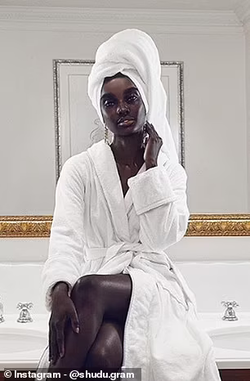
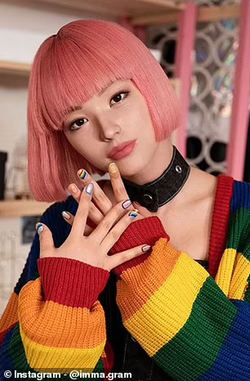
Other digital social media stars include a model named Shudu (left), who has racked up 232,000 followers, and a Japanese girl named Imma (right), who has 382,000 followers
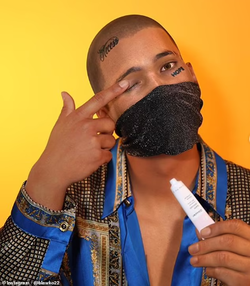
Lawko, who has 143,000 followers, is another fake influencer. He was created in 2017 and is a self-confessed slob and ‘young robot sex symbol’
Research shows that while more than half of Miquela’s followers are in the 18 to 24 age group, many are also under 17.
So will knowing that their Insta-idols are fake give them more or less to live up to? Marketing expert Scott Guthrie says virtual influencers' often stick-thin bodies and flawless complexions simply reinforce unrealistic beauty standards.
Andy Phippen, Professor of IT Ethics and Digital Rights at Bournemouth University, explained: ‘Avatars like Miquela are typically skinny with big eyes.
'Even compared to influencers who use filters, this really is a completely unrealistic representation of body image - because it’s not even real. Both promote unhealthy body image and unrealistic expectations.
‘It falls to parents to help their children understand that what is online is sometimes not what it seems.
'Young people need help to learn how to make informed judgments when seeing content like this.’
At first glance, Miquela looks like any Instagram influencer. The feed of this ‘forever 19-year-old’ is full of the usual shots of her posing drinking coffee in leisure wear and taking selfies with her phone.
In her comments, she shares her heartbreak at splitting up with a boyfriend, complains about her allergies and how much she needs an iced matcha when it’s hot, even though she has never left a computer screen.
The FAKE influencer trying to inspire 'real' change: Kami, the world's first VIRTUAL social media star with Down syndrome, launches Instagram to try and hit back at 'filtered and perfect' beauty standards online
- Kami may look like a real person, but she is actually a computer graphics animation made of pixels, who only exists on-screen
- The young social media user - who has a bright smile and long, purple hair - was created as a way to counter the ‘perfect’ internet personas
- She was created by Down Syndrome International (DSi), creative agency Forsman & Bodenfors (F&B), and global digital modelling agency The Diigitals
- They teamed up to make the virtual influencer since they said the 'digital world isn't an inclusive space'
- The three companies wanted to give people with disabilities someone to relate to, since they said almost all influencers looks 'curated, filtered, and perfect'
- A panel of over 100 young women volunteers with Down syndrome were consulted during her creation - acting faces and gestures that Kami will embody
Kami may look like a real person, but she is actually a computer graphics animation made of pixels, who only exists on-screen.
The young social media user - who has a bright smile and long, purple hair - was created as a way to counter the ‘perfect’ internet personas and the lack of high profile people who have disabilities.
She was created by Down Syndrome International (DSi), creative agency Forsman & Bodenfors (F&B), and global digital modelling agency The Diigitals.
They teamed up to make the virtual influencer since they said the 'digital world isn't an inclusive space.'
The three companies wanted to give people with disabilities someone to relate to, since they said almost all influencers looks 'curated, filtered, and pixel perfect.'


Kami may look like a real person, but she is actually a computer graphics animation made of pixels, who only exists on-screen


The young social media user - who has a bright smile and long, purple hair - was created as a way to counter the ‘perfect’ internet personas
Kami, short for the name Kamilah, means perfection in Arabic, and that is how they want the world to see her.
The group explained, 'Despite being a more connected society, the digital world is yet to fully embrace diversity.
'Avatars that allow us to choose an “ideal” face and body lead to the heavy underrepresentation and the reduced visibility of people with disabilities.
'By intentionally giving Down syndrome to someone who is universally known as "perfect" in the social sphere, Kami will be a powerful representation that Down syndrome is not a flaw, or a mistake, and that she does not need "fixing."'
For Kami to be a truly authentic representation of real women with Down syndrome, a panel of over 100 young women volunteers with Down syndrome across the DSi global network were consulted to collaborate on her creation as a virtual model - acting as the faces, physiques, gestures, voices, and personalities that Kami will embody.
'The digital world isn't an inclusive space. Everyone looks curated, filtered, pixel perfect - but change is coming,' an introduction video shared to her Instagram account reads.
'Meet Kami,' it continued. 'The world's first virtual influencer with Down syndrome. I'm not real but I'm made from hundreds of real women with one common mission - to make the digital world a place where everyone truly belongs.'

She was created by Down Syndrome International (DSi), creative agency Forsman & Bodenfors (F&B), and global digital modelling agency The Diigitals
A panel of over 100 young women volunteers with Down syndrome were consulted to collaborate on her creation

The three companies wanted to give people with disabilities someone to relate to, since they said almost all influencers looks 'curated, filtered, and pixel perfect'
One of the women volunteers with Down syndrome is Jaspreet Sekhon, from Singapore.
Jaspreet said: 'I don’t really see people with Down syndrome on social media. I wish there was more like us.
'If I saw more people with Down syndrome, it would make us confident in ourselves. Show people what we can do and then show it on social media.'
According to a study published by the Institute of Digital Fashion, as reported by Adweek, 60 per cent of people said there was a lack of inclusivity in digital spheres.
'In a world filled with pixel perfect virtual models, creating Kami is a way to completely reframe Down syndrome in the online space,' added Rachel Kennedy and Firrdaus Yusoff, creatives for Forsman & Bodenfors Singapore.
'We want to make it impossible to ignore Kami and everything she stands for. As we get to know her, Kami’s true potential will depend on how the world embraces her in her virtual form.'
Adweek reported that Kami was created through using 'both machine learning and human craft.'
'Portraits of the women were aligned before being added to a face averaging program to produce a single image,' the outlet explained.
'A 3D character creator program called Daz3D then generated the initial concept and face of Kami.
'With this prototype, the team crafted her human features - from her eyelashes to skin textures - in 3D form. The avatar can be imported into different platforms.'
'We really wanted Kami’s DNA to represent all the faces and aspects of these women with Down syndrome, which the program allowed us to do,' said Cameron James-Wilson, founder and CEO of The Diigitals.
'Creating characters like Kami signify a challenge to the many layers of digital interface that currently lack inclusivity.

It turns out, this isn't the first virtual influencer. Back in 2016, an LA-based company called Brud created a fake person named Miquela Sousa, also known as Lil Miquela (pictured)

The effortlessly cool 19-year-old robot has since racked up more than three million followers, and has modeled for brands such as Prada and Chanel

Miquela was created with a different approach than Kami. From her Brazilian background to the cute freckles on her nose, everything about her is manufactured to appear perfect
'We need to address some of the glaring problems in this space and build the online world we want for the future.'
You can follow Kami on Instagram at @itskamisworld, where she has already gained around 800 followers.
It turns out, this isn't the first virtual influencer. Back in 2016, an LA-based company called Brud created a fake person named Miquela Sousa, also known as Lil Miquela, and started sharing her pictures online.
The effortlessly cool 19-year-old robot has since racked up more than three million followers, and has modeled for brands such as Prada and Chanel, which pay good money to have their products adorn her close-to-perfect body.
However, Miquela was created with a different approach than Kami. From her exotic Spanish-Brazilian background to the cute freckles on her nose (designed to give her an imperfect beauty and make her more ‘relatable’), everything about her is manufactured.
It is said that the ‘virtual influencers’ have become so life-like that one survey found 42 per cent of youngsters have followed a fake person without even realizing they were CGI.
So why hire a human to sell your products when you can construct the perfect brand ambassador of your own?
Miquela will always be ‘on message’ and will never go through a scandal. Moreover, she will be 19, and beautiful, forever.
‘A CGI influencer has no personal life that can create a PR nightmare for the brand: no messy divorce, no drug abuse,’ says Stefano Marrone, managing director of strategic content agency Nucco Brain.
But what effect will this next generation of influencers have on the minds of young people who are already struggling with feeling like they can’t compete with airbrushed perfection?

Other virtual influencers include a blonde beauty named Bermuda, who has 271,000 followers. She has describes herself as ‘an unbothered mogul with Daddy’s PIN and flawless highlights’


Other digital social media stars include a model named Shudu (left), who has racked up 232,000 followers, and a Japanese girl named Imma (right), who has 382,000 followers

Lawko, who has 143,000 followers, is another fake influencer. He was created in 2017 and is a self-confessed slob and ‘young robot sex symbol’
Research shows that while more than half of Miquela’s followers are in the 18 to 24 age group, many are also under 17.
So will knowing that their Insta-idols are fake give them more or less to live up to? Marketing expert Scott Guthrie says virtual influencers' often stick-thin bodies and flawless complexions simply reinforce unrealistic beauty standards.
Andy Phippen, Professor of IT Ethics and Digital Rights at Bournemouth University, explained: ‘Avatars like Miquela are typically skinny with big eyes.
'Even compared to influencers who use filters, this really is a completely unrealistic representation of body image - because it’s not even real. Both promote unhealthy body image and unrealistic expectations.
‘It falls to parents to help their children understand that what is online is sometimes not what it seems.
'Young people need help to learn how to make informed judgments when seeing content like this.’
At first glance, Miquela looks like any Instagram influencer. The feed of this ‘forever 19-year-old’ is full of the usual shots of her posing drinking coffee in leisure wear and taking selfies with her phone.
In her comments, she shares her heartbreak at splitting up with a boyfriend, complains about her allergies and how much she needs an iced matcha when it’s hot, even though she has never left a computer screen.